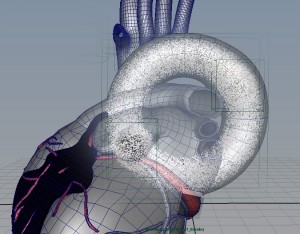What is blood pressure? The video shows the expansion of a blood vessel wall with each heart beat, the aorta expands in this movie!
Using Maya, the heart model was made to beat by using a simple lattice deformer with 2x2x2 division and also clusters for secondary motion. For reference, I used a movie clip of actual open heart surgery, and then isolated one beat from the clip. After tweaking the 3D models motion for a day or two, all animated parts where made into a Maya trax clip of a single heart beat of animation. The single trax beat was then able to be looped using the trax editor as many times as needed, and also speed up or down using the editor.
The RBCs inside the aorta are made using a single model of an RBC instanced onto a vast number of particles. The particles are shaped in the form of a donut or torus by animating an omni emitter around in a “circle”, and then setting an initial state for the particle. A per particle creation expression is also used to randomly rotate each RBC as each particle is created.
The aorta of the heart, and the aorta cross section, are modeled using the same nurbs curve “circle” that the emitter followed when forming the torus of particles. In Maya, particles can be deformed in just the same way as geometry can. The nice thing here is that the instanced RBCs are not stretched by the deformation of the particle. The RBCs simply follow the position of the deformed torus of particles.
A sculpt deformer was applied to both the torus of particles and also the Aorta’s geometry at the same time. Then the sculpt deformer and locator are parented inside the nurbs “circle” used for the emitters path, as well as parenting the torus of particles inside the “circle”.
The nurbs circle’s rotation was then animated over time in sync with the beat of the heart. The sculpt deformer that is parented inside the “circle” causes a bulge in the aorta wall as it slides around the geometry, and the same sculpt deformer causes the torus of particles RBCs to bulge out and fill in the aortas empty deformed space with each heart beat.
Usually I would use a per particle expression to rotate the instanced RBCs over time, according to each particles velocity. The faster each RBC travels, the faster it will rotate. However, the deformed particle shape did not allow for this per particle type of expression to be used. As a solution, I rotated only the single instanced RBC model used for all particles, and in sync with the heart beat. Because the RBCs motion is so fast, this solution could be used, and not seen as a fake rotation.
